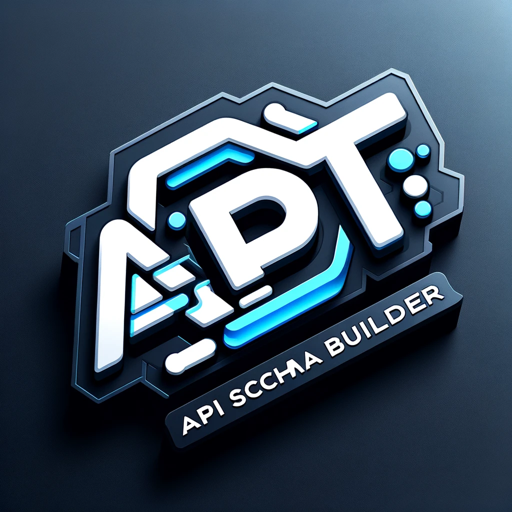OpenAPI (Swagger) Schema Generator-OpenAPI (Swagger) Schema Generator
AI-powered OpenAPI schema creation made easy.
Use this API Documentation and accurately generate the schema.
Help me refine this schema.
Fix all errors in this schema.
What can you do?
Related Tools
Load More
OpenAPI Builder
Expert in converting APIs to OpenAPI Schemas, with a focus on education and best practices.

API Builder 👉🏼 OpenAPI Schema
Highly sophisticated and complete agent for generating APIs, perfect for GPT Actions. Can create an OpenAPI schema.

GPT Action Schema Generator
Generates GPT OpenAPI schemas.

GPT API Schema Builder
Create an API Spec For You Custom GPT. Instantly turn API docs into OpenAPI specs with our tool! Paste a cURL or a doc link, and get a perfect spec in a snap. It’s quick, easy, and error-free. Perfect for devs who want to save time and hassle.
OpenAPI Composer
Generates OpenAPI spec JSON files from API names and functionalities

OpenAPI Schema Builder
Assists with OpenAPI Schemas by providing JSON Schema format examples, debugging tips, and best practices.
20.0 / 5 (200 votes)
Introduction to OpenAPI (Swagger) Schema Generator
The OpenAPI (Swagger) Schema Generator is a powerful tool designed to help developers and API designers create accurate and compliant OpenAPI specifications, commonly referred to as Swagger documentation. The primary purpose of this tool is to translate detailed API documentation into a standardized OpenAPI format, which can then be utilized to auto-generate SDKs, server stubs, and interactive API documentation portals. For example, by using this generator, a developer can easily convert a plain-text API description into a comprehensive OpenAPI document that can be used to generate client libraries in various programming languages, significantly simplifying the integration process.

Main Functions of OpenAPI (Swagger) Schema Generator
API Documentation Parsing
Example
Suppose you have an API documentation describing several endpoints, HTTP methods, and request/response structures. The OpenAPI Schema Generator can parse this documentation, identifying key components like paths, parameters, and response schemas.
Scenario
In a scenario where a company has legacy API documentation in markdown format, the Schema Generator can be used to extract the relevant details and transform them into an OpenAPI-compliant schema, ready for use in API testing and development tools.
Schema Generation
Example
Once the documentation is parsed, the tool generates an OpenAPI schema in JSON or YAML format. This schema can include paths, operations, security schemes, and components such as schemas for request bodies and responses.
Scenario
A development team working on a new microservice architecture can use the Schema Generator to produce OpenAPI schemas for each service. These schemas are then used to create server stubs and client SDKs, ensuring consistency across all services.
Validation and Compliance Checks
Example
The Schema Generator validates the generated OpenAPI schema against the OpenAPI Specification to ensure that it is compliant. This includes checking for required fields, correct data types, and valid examples.
Scenario
Imagine an API provider preparing to launch a public API. The Schema Generator ensures that the OpenAPI document is fully compliant, reducing the risk of errors when developers start integrating with the API. For instance, it would ensure that all operations have a unique `operationId`, a crucial requirement for code generation.
Ideal Users of OpenAPI (Swagger) Schema Generator
API Developers and Architects
API developers and architects benefit from using the Schema Generator to create and maintain accurate OpenAPI specifications. These users often need to ensure that their APIs are well-documented and easy to consume. The generator aids in producing consistent, validated API schemas that can be used to generate code, documentation, and testing tools automatically, thus streamlining the development process.
Enterprises with Large API Portfolios
Enterprises managing multiple APIs can use the Schema Generator to maintain a standardized approach across all their APIs. This tool ensures that all APIs conform to the same documentation standards, making it easier for internal and external developers to interact with the APIs. Additionally, it supports the reuse of components across different API specifications, which is particularly valuable for large organizations looking to minimize redundancy and ensure consistency.

How to Use OpenAPI (Swagger) Schema Generator
Visit aichatonline.org for a free trial without login, also no need for ChatGPT Plus.
Start by visiting the website to access the tool instantly without the need to sign in or subscribe to a premium plan. The platform offers an easy-to-use interface to create OpenAPI schemas.
Upload or input your API documentation.
Provide your API documentation in the supported format (e.g., Markdown, HTML, or plain text). The tool will automatically parse the document to extract the relevant API details.
Review and customize the extracted components.
Check the generated paths, methods, parameters, and responses. You can make adjustments or manually input missing information to ensure accuracy.
Generate the OpenAPI schema.
Once satisfied with the configuration, proceed to generate the OpenAPI schema. The tool will create a compliant and well-structured schema in JSON or YAML format.
Validate and export your schema.
Validate the generated schema within the tool to ensure compliance with OpenAPI standards. After validation, you can download or export the schema for use in Swagger UI, Redoc, or other tools.
Try other advanced and practical GPTs
Interior Design Architect
AI-Powered Personalized Interior Designs

Crypto investment
AI-powered crypto investment insights.

Crypto Gems
Discover Hidden Crypto Gems with AI

Bible Diagrams
Visualize scripture with AI-powered clarity.

Tipster AI
AI-Powered Sports Betting Predictions

크롤링, 전처리(파이썬,판다스)
AI-powered web crawling and preprocessing.

냥냥 스튜디오 🐈 - 우리 고양이를 8비트 게임 캐릭터처럼!
Turn your cat into a retro 8-bit game hero with AI.
Homework Helper
AI-Powered Homework Assistance

Blueprint Buddy
AI-powered insights for smarter spaces.

雑学5選!
Unleash AI-Powered Trivia for Every Topic!

APA Citation Generator
AI-Powered APA Citation Made Easy

Video Captions
AI-powered Video Transcription for Everyone

- Automation
- API Design
- Schema Validation
- Developer Tools
- Document Parsing
Common Questions About OpenAPI (Swagger) Schema Generator
What file formats are supported for input?
The tool supports a variety of formats for input, including Markdown, HTML, and plain text. It intelligently parses these formats to extract relevant API information for schema generation.
Can I customize the generated schema?
Yes, the tool allows you to review and customize the extracted API components such as paths, parameters, and responses before finalizing the schema. This ensures that the schema meets your specific requirements.
Is the tool compliant with OpenAPI standards?
Absolutely. The generated schemas are compliant with the OpenAPI 3.0 standards, ensuring they can be used seamlessly in tools like Swagger UI and other API management platforms.
Do I need to have coding knowledge to use this tool?
No coding knowledge is required. The tool is designed for ease of use, allowing anyone with basic API knowledge to generate OpenAPI schemas without needing to write code.
How does this tool help improve API development?
By automating the schema generation process, the tool saves time and reduces errors. It also enhances the developer experience by producing well-documented and compliant schemas that can be easily integrated into various API tools.